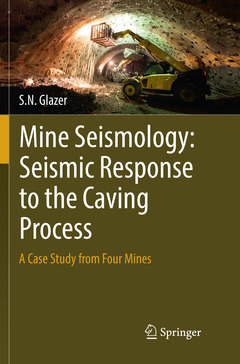Description
Mine Seismology: Seismic Response to the Caving Process, Softcover reprint of the original 1st ed. 2019
A Case Study from Four Mines
Author: Glazer S.N.
Language: English
Subjects for Mine Seismology: Seismic Response to the Caving Process:
Approximative price 52.74 €
In Print (Delivery period: 15 days).
Add to cartPublication date: 12-2018
Support: Print on demand
Approximative price 52.74 €
In Print (Delivery period: 15 days).
Add to cartPublication date: 08-2018
Support: Print on demand
Description
/li>Contents
/li>Biography
/li>Comment
/li>
- How to establish which seismic data base is faulty and why
- The formation of a universal seismic response to the caving process
- Indisputable evidence that hydro-fracturing improves underground safety ?
- Basic research, applied research and implementation
- Predicting mine-induced seismic events
- Quantitative versus qualitative seismology
- Research versus pseudo-research
- What is genuine research?
I consider Stefan the pioneer of using microseismic data to provide understanding of the mechanism and progress of cave mining. Science has advanced considerably since the use of less than reliable extensometers to monitor the cave back position and Stefan was leading this advance. (?)This book provides a lot of useful insight[s] in how we can best understand the data that we (?) gather and how to change this data into useful information. Neil Hepworth C. Eng, MIMMM, Geomin Consultorio ? Brazil. Consultant Mining and Geotechnics
Stefan mine seismology trilogy is (?) a comprehensive tutoring on how to analyse and interpret mine induced seismicity. This coaching is based on multiple practical examples (?) presented from the problem to be solved [with] input data tests followed by analysis and interpretation. This last is presented with many details that explain the whole process. Mahdi Bayuargo, ST, MAScPT. Duaem Gada Bayuagus Managing Director
Stefan N. Glazer has over 40 years of experience in the application of geophysical methods in the mineral prospecting and mining industry. He has been an independent mine seismology consultant since 2004, and before that he worked as a mine seismologist for AngloGold and then PMC. He holds an MSc degree in Prospecting Geophysics (1972) and a PhD degree in Mine Geophysics (1997), both from the AGH University of Science and Technology, Krakow, Poland.
He has published a number of technical papers, the last eleven of which were on monitoring the PMC caving process. He was involved in the Mass Mining Technology 2 Project; in this regard he wrote on the “seismic signature of the caving process,” which involved the analysis and interpretation of seismicity recorded at El Teniente, Chile, PT Freeport DOZ Mine, Northparkes Mine Lift 2 and PMC. The aim of this research was to make maximum use of the recorded seismicity to monitor and manage the caving process. In 2007 and 2011 he lectured on the subject of Mining Induced Seismicity for the Master Program in Geomechanics Applied to Mining at the School of Engineering, Universidad de Los Andes, Santiago, Chile. Between 1980 and 2012 Stefan published 19 papers, including 15 on mine seismology.
Serves as an interpretation guide
Presents analysis of large data sets
Illustrates seismicity induced by the caving process
Deals with qualitative and quantitative mine seismology

